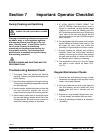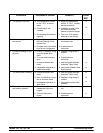
21
Models 150, 152, 162, 168 Operating Procedures
When the solution stops flowing from the door spout,
lower the draw valve and place the power switch in the
“OFF” position.
Repeat Steps 1 through 5 for the other side of the
freezer on Models 162/168.
Disassembly
Step 1
BE SURE THE POWER SWITCH IS IN THE “OFF”
POSITION.
Step 2
Remove the handscrews and the freezer door.
Remove the beater assembly(ies) from the freezing
cylinder(s) and take these parts to the sink for
cleaning.
Step 3
Remove the front drip tray and the splash s hield from
the freezer. Take them to the sink for cleaning.
Brush Cleaning
Step 1
Prepare a sink with an approved cleaning solution.
USE WARM WATER AND FOLLOW THE MANUFAC-
TURER’S SPECIFICATIONS.
IMPORTANT: Follow label directions, as too
STRONG of a solution can cause parts damage, while
too MILD of a solution will not provide adequate
cleaning.) Make sure all brushes provided with the
freezer are available for brush cleaning.
Step 2
Remove the o-ring(s) from the drive shaft(s) of the
beater assembly(ies).
Note: To remove the o-rings, use a single service
towel to grasp the o-ring. Apply pressure in an upward
direction until the o-ring pops out of its groove. With the
other hand, push the top of the o-ring forward, and it
will roll out of the groove and can be easily removed.
If there is more than one o-ring to be removed, always
remove the rear o-ring first. This will allow the o-ring to
slide over the forward rings without falling into the open
grooves.
Step 3
From the freezer door, remove the design cap, draw
valve handle, valve lifter arm, and draw valve. Remove
all o-rings.
Models 162/168: From the freezer door, remove
design caps, pivot pins, draw handles, draw valves,
and the center draw valve. Remove all o-rings.
Step 4
Remove the large o-ring(s), front bearing(s), and guide
bearing(s) from the back of the freezer door.
Step 5
Return to the freezer with a small amount of cleaning
solution. With the black bristle brush, brush clean the
rear shell bearing(s) at the back of the freezing
cylinder(s).


















